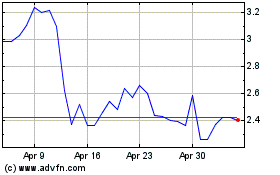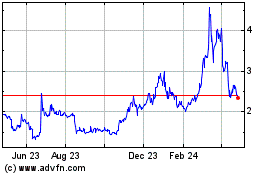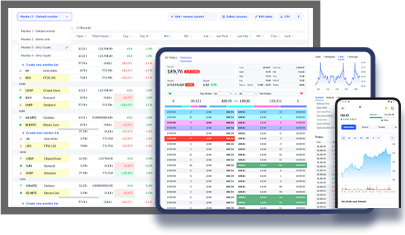After Celsius: How Crypto Lenders Can Improve Sustainability
August 23 2022 - 8:25AM
NEWSBTC
We’re in the midst of an intriguing cryptocurrency bear market, to
say the least. The past several months provided high-profile
collapses such as algorithmic stablecoin TerraUSD, crypto hedge
fund Three Arrows Capital and more recently, crypto lender Celsius
Network. While overall macro events take some responsibility for
the failure of these organizations, there’s more to it than that.
Celsius, in particular, left a gaping hole in the crypto lending
industry due to their unsustainable business model and risky,
off-platform practices. Now, as Celsius attends its bankruptcy
trial, analysts are gathering around to see just what went wrong
and how crypto lenders can improve sustainability going forward.
Why did Celsius Network collapse? This week, crypto lending
platform Celsius filed for bankruptcy. A move that came with no
surprise. Ever since Celsius froze its user’s assets a few weeks
ago, it was just a matter of time before the once powerful lending
platform collapsed. But how did they get to that point, to begin
with? Last year, CEO Alex Mashinsky announced that Celsius has a
total of $25 billion in assets under management. Now, that number
is down to just $156 million. Celsius still owes around $4.7
billion to its customers plus a mysterious $1.2 billion hole found
on its balance sheet. The source of this implosion is traced to
leverage. Blockchain researchers used on-chain data to theorize
Celsius allegedly used DeFi protocols for yield farming strategies
with its client’s funds. Celsius was famous for offering a high
yield to its clients that held crypto on its platforms. Now, we’re
learning this yield came from these off-platform, DeFi yield
farming strategies. Adding to the case, Nic Carter from venture
capital firm Castle Island Ventures went on CNBC to suggest Celsius
were “subsidizing it [the yields] and taking losses to get clients
in the door. The yields on the other end were fake and subsidized.
They were pulling through returns from [Ponzi schemes]. Lending
funds to DeFi protocols comes with a variety of risks. For one,
there is an overall protocol risk, smart contract failure risk, and
of course, exposure to volatile markets. Several macroeconomic
events resulted in market volatility, crashing crypto prices, and
liquidating Celsius’s risky loans in the process. This resulted in
a permanent loss of client funds. How did the market react?
Financial markets are partially driven by emotion. Typically, when
there is a lot of fear in the market, prices decrease. If there is
an excess of greed, prices increase. The Celsius event is a classic
example of how mass fear is induced. When the crypto market bull
run came to an abrupt end in 2022, many investors (including
Celsius) were unprepared. Investors were fearful and began
withdrawing liquidity from Celsius faster than other users were
depositing it. Hence, Celsius were forced to lock withdrawals to
maintain whatever liquidity it had left. When the market tanked
even further, their leveraged long positions were liquidated. The
Celsius name is now tarnished and its CEL token is now trading at
around 70 cents, down from nearly $8 a year ago. Fear and lack of
trust within the crypto market are at high levels. A large part of
this is due to poor business practices from companies like Celsius,
in addition to the overall global economy. It’s a perfect storm for
a long, cold bear market. One we are in the midst of right now. As
we all know, however, prices move in waves. The market will recover
and brighter days are ahead. Bear markets are the perfect
opportunity for crypto lenders to look within themselves and
develop a more sustainable business model. That way, they can avoid
such disastrous failures in the future. How crypto lending can
improve in the future Using client funds for risk investment
maneuvers is not a new concept. We’ve seen this many times in both
traditional financial markets and within the cryptocurrency
industry. Yet, when the strategy fails, the results are disastrous.
Within the niche of crypto lending, there is always some element of
risk. Yet, with a sustainable business model, this risk is
mitigated more effectively. Take European FinTech platform
YouHodler for example. Starting in 2018 as a simple crypto lending
platform, YouHodler has since evolved to become a multifaceted
crypto wallet, exchange, yield generation tool, and crypto trading
solution. Like Celsius, YouHodler offers yield on crypto deposits
but the similarities stop there. Speaking with CoinTelegraph in a
live “ask me anything” session, YouHodler CEO Ilya Volkov revealed
key aspects of YouHodler’s business model that other crypto lenders
can use for inspiration. Volkov states that Youhodler is a
“self-sufficient” platform that is not backed by an initial coin
offering (ICO) or venture capitalization. Client funds are never
placed under anyone’s management besides YouHodler. “We keep all
client operations within the platform and have zero connections to
other DeFi protocols,” said Volkov. “We realize this results in
more conservative returns for our clients but ultimately, it is a
more secure and sustainable approach to yield generation.
Protecting our client’s funds is a primary goal of ours.” YouHodler
is also big on never “over-promising and under-delivering.” The
company takes a realistic approach to expectations. For example,
the current market environment caused YouHodler to decrease the
maximum amount that each client can earn a yield – from $100,000 to
$25,000. While it’s an inconvenience to some clients, it’s a
necessary move to keep operations working efficiently. When the
market recovers, these amounts will rise again. Bear markets are
never easy but there is a formula to them. Just as we are seeing
now, there is a lot of panic in the market. Celsius didn’t help
that panic nor did the high inflation, key rate hikes from central
banks, and the constant talks of a global recession. However,
companies like YouHodler were born in previous bear markets and
went on to thrive. Without a doubt, this current “crypto winter”
will produce new innovative solutions to our most important
financial problems. We can only hope they are approached with a new
focus on sustainability instead of pure profitability. Only then
will this market reach peak maturity and achieve its maximum
potential.
Waves (COIN:WAVESUSD)
Historical Stock Chart
From Oct 2024 to Nov 2024

Waves (COIN:WAVESUSD)
Historical Stock Chart
From Nov 2023 to Nov 2024


